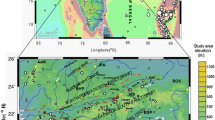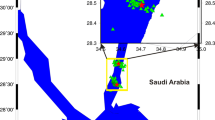Abstract
On January 26, 2020, a moderate-sized earthquake (ML ~ 4.6) located in the Palnadu sub-basin of Cuddapah basin was felt both in the states of Telangana and Andhra Pradesh. The earthquakes prior and after the ML 4.6 are located close to the thrust and along the periphery of the backwaters of the Pulichintala Reservoir. About 965 earthquakes in the magnitude range of 0.1–4.6 ML have been located by seismological network. The epicentral parameters obtained from double difference technique illuminated a steep seismogenic structure extending up to 8 km depth using a minimum 1-D velocity model. The b-value estimate is 0.82 for a completeness magnitude of Mc 1.8 and could be associated with the intraplate event having a longer recurrence time. The focal mechanism solution obtained from waveform inversion reveals a pure double-couple mechanism of a strike-slip motion with a reverse component on a N–S trending focal plane. The spatial distribution of the earthquake sequence and fault plane solution of the main event are close to a thrust which is the most likely source region of the main-shock.
Highlights
-
Relocation of the Palnadu earthquake sequence illuminated a steep seismogenic structure extending up to 8 km depth.
-
The estimated lower b-value (0.82) could be associated with the intraplate event having a longer recurrence time.
-
The focal mechanism solution of the main-shock (ML 4.6) shows a strike-slip motion with a reverse component.




Similar content being viewed by others
References
Chandra U 1977 Earthquakes of peninsular India – a seismotectonic study; Bull. Seismol. Soc. Am. 67(5) 1387–1413.
Chatterjee N and Bhattacharji S 1998 Formation of Proterozoic tholeiite intrusives in and around Cuddapah basin, South India and their Gondwana counterparts in East Antarctica and compositional variation in their mantle sources; N. Jb. Miner.-Abh. 174 79–102.
Craig T and Heyburn R 2015 An enigmatic earthquake in the continental mantle lithosphere of stable North America; Earth Planet. Sci. Lett. 425 12–23.
Dziewonski A 1981 Routine determination of source parameters from the analysis of wave forms recorded by the global digital network; Tech. rep., Semi-annual Technical Report, Seismic Discrimination, 1 October 1980–31 March 1981.
Ekström G, Nettles M and Dziewoński A M 2012 The global CMT project 2004–2010: Centroid-moment tensors for 13,017 earthquakes; Phys. Earth Planet. Int. 200 1–9.
Ford S R, Dreger D S and Walter W R 2009 Identifying isotropic events using regional moment tensor inversion; J. Geophys. Res.: Solid Earth 114(B1).
Gangrade B K and Arora S K 2000 Seismicity of the Indian peninsular shield from regional earthquake data; Pure Appl. Geophys. 157(10) 1683–1705.
Gowd T, Rao S S and Gaur V 1992 Tectonic stress field in the Indian subcontinent; J. Geophys. Res.: Solid Earth 97(B8) 11,879–11,888.
Geological Survey of India 2000 Seismo Tectonic Atlas of India and its Environs, 1:1 million scale, Bangalore.
Gutenberg B and Richter C F 1944 Frequency of earthquakes in California; Bull. Seismol. Soc. Am. 34(4) 185–188.
Heidbach O, Tingay M, Barth A, Reinecker J, Kurfeß D and Müller B 2008 The world stress map database release 2008; GFZ Data Services, https://doi.org/10.1594/gfz.WSMRel2008.
Heimann S, Gonzales A, Cesca S, Wang R and Dahm T 2013 Seismic characterization of the terminal explosion of the Chelyabinsk meteor; Geophys. Res. Lett. 84(6) 1021–1025.
Herrmann R B 2013 Computer programs in seismology: An evolving tool for instruction and research; Seismol. Res. Lett. 84(6) 1081–1088.
Herman M W, Herrmann R B, Benz H M and Furlong K P 2014 Using regional moment tensors to constrain the kinematics and stress evolution of the 2010–2013 Canterbury earthquake sequence, South Island, New Zealand; Tectonophys. 633 1–15.
Herrmann R B, Benz H and Ammon C J 2011a Monitoring the earthquake source process in North America; Bull. Seismol. Soc. Am. 101(6) 2609–2625.
Herrmann R B, Malagnini L and Munafò I 2011b Regional moment tensors of the 2009 l’aquila earthquake sequence regional moment tensors of the 2009 l’aquila earthquake sequence; Bull. Seismol. Soc. Am. 101(3) 975–993.
Kaila K and Bhatia S 1981 Gravity study along the Kavali–Udipi deep seismic sounding profile in the Indian peninsular shield: Some inferences about the origin of anorthosites and the eastern ghats orogeny; Tectonophys. 79(1–2) 129–143.
Kaila K L and Tiwari H C 1985 Structural trends in the Cuddapah basin from deep seismic soundings (DSS) and their tectonic implications; Tectonophys. 115 69–86.
Kissling E, Solarino S and Cattaneo M 1995 Improved seismic velocity reference model from local earthquake data in northwestern Italy; Terra Nova 7(5) 528–534.
Mandal P, Rastogi B K and Gupta H K 2000 Recent Indian earthquakes; Curr. Sci. 79(9) 1334–1346.
Matin A 2015 Tectonics of the Cuddapah basin and a model of its evolution: A review; Geol. Soc. Lond., Memoirs 43(1) 231–254.
McKenzie D P 1969 The relation between fault plane solutions for earthquakes and the directions of the principal stresses; Bull. Seismol. Soc. Am. 59(2) 591–601.
Meng X, Yang H and Peng Z 2018 Foreshocks, b value map, and aftershock triggering for the 2011 mw 5.7 Virginia earthquake; J. Geophys. Res.: Solid Earth 123(6) 5082–5098.
Mishra D C, Baburao V, Laxman G, Rao M B S and Venkatarayudu M 1987 Three-dimensional structural model of Cuddapah basin and adjacent eastern part from geophysical studies; Mem. Geol. Soc. India 6 313–330.
Nagaraja Rao B, Rajurkar S, Ramalingaswamy G and Ravindra Babu B 1987 Stratigraphy, structure and evolution of the Cuddapah basin; Geol. Soc. India Memoir 6 33–86.
Naqvi S M and Rogers J J W 1987 Precambrian Geology of India; Oxford University Press, Oxford.
Ottemöller L, Voss P and Havskov J 2013 Seisan earthquake analysis software for windows; solaris, linux and macosx.
Rao B R and Rao P S 1984 Historical seismicity of peninsular India; Bull. Seismol. Soc. Am. 74(6) 2519–2533.
Rao C and Venkata N 1997 Petrogenesis of proterozoic kimberlites and lamproites from the Cuddapah basin and Dharwar craton, Southern India; PhD thesis, University of Cambridge.
Rastogi B 1992 Seismotectonics inferred from earthquakes and earthquake sequences in India during the 1980s; Curr. Sci. 62(1–2) 101–108.
Reddy P R, Chandrakala K, Prasad A S S S R S and Rao C R 2004 Lateral and vertical crustal velocity and density variations in the Southwestern Cuddapah basin and adjoining Eastern Dharwar Craton; Curr. Sci. 87(11) 1607–1614.
Saha D and Chakraborty S 2003 Deformation pattern in the Kurnool and Nallarnalai groups in the northeastern part (Palnad area) of the Cuddapah basin, south India and its implication on Rodinia/Gondwana tectonics; Gondwana Res. 6(4) 573–583.
Singh C, Basha S, Shekar M and Chadha R 2012 Spatial variation of coda wave attenuation in the southern Indian shield and its implications; Geologica Acta 10(3) 309–318.
Sipkin S A and Needham R E 1993 Moment-tensor solutions estimated using optimal filter theory: Global seismicity 1991; PEPI 75(4) 199–204.
Sivaram K, Saikia U, Nagaraju K and Dinesh K 2017 Attenuation characteristics of high frequency seismic waves in southern India; Pure Appl. Geophys. 174 2523–2545, https://doi.org/10.1007/s00024-017-1574-2.
Srinagesh D, Chadha R, Raju P S, Suresh G, Vijayaraghavan R, Sarma A, Sekhar M and Murty Y 2015 Seismicity studies in eastern Dharwar craton and neighbouring tectonic regions; J. Geol. Soc. India 85(4) 419–430.
Townend J and Zoback M D 2000 How faulting keeps the crust strong; Geology 28 399–402.
Tripathy V and Saha D 2013 Plate margin paleostress variations and intracontinental deformations in the evolution of the Cuddapah basin through Proterozoic; Precamb. Res. 235 107–130.
Vavryčuk V and Kim S G 2014 Nonisotropic radiation of the 2013 north Korean nuclear explo-Sion; Geophys. Res. Lett. 41(20) 7048–7056.
Waldhauser F and Ellsworth W L 2000 A double-difference earthquake location algorithm: Method and application to the northern hayward fault, California; Bull. Seismol. Soc. Am. 90(6) 1353–1368.
Wessel P and Smith W H F 1998 New, improved version of the Generic Mapping Tools released; Eos. Trans. AGU 79 579.
Wiemer S 2001 A software package to analyze seismicity: Zmap; Seismol. Res. Lett. 72(3) 373–382.
Zoback M D, Barton C A, Brudy M, Castillo D A, Finkbeiner T, Grollimund B R and Wiprut D J 2003 Determination of stress orientation and magnitude in deep wells; Int. J. Rock Mech. Min. Sci. 40(7–8) 1049–1076.
Zoback M D and Townend J 2001 Implications of hydrostatic pore pressures and high crustal strength for the deformation of intraplate lithosphere; Tectonophys. 336(1–4) 19–30.
Acknowledgements
We are thankful to the Director, CSIR-NGRI Hyderabad for his support and permission to publish this work. This research was supported by the Mission Mode Project of CSIR, HCP-17 CSIR-NGRI. We are grateful to the Editor, N V Chalapathi Rao and two anonymous reviewers for providing us with interesting suggestions that helped us in improving the article’s scientific quality as well as its readability. The lead author acknowledges the help rendered by district authorities in obtaining permissions and logistic support for the installation of the closed spacing seismic station network. Maps were plotted using the Generic Mapping Tools (Wessel and Smith 1998).
Author information
Authors and Affiliations
Contributions
Overall, this work has been supervised and conceptualized by Dr D Srinagesh, who planned, executed the field program, and significantly contributed in writing the paper. Sunilkumar T C contributed in estimating the focal mechanism and manuscript preparation; Dr Prantik Mandal for estimating 1-D velocity model and b-values; Naresh Bandari and Dr Solomon Raju involved in recomputing the seismicity and plotting the trends. Vitthal S, Dhiraj K Singh, Dr V Pavan Kumar, Ravi P Singh, Mahalaxmi Naidu, Suresh Gudapati, and A N S Sarma involved in deployment of seismological stations data collection and analysis.
Corresponding author
Additional information
Communicated by N V Chalapathi Rao
Rights and permissions
About this article
Cite this article
Srinagesh, D., Sunilkumar, T.C., Naresh, B. et al. A study of Palnadu earthquake sequence in the Cuddapah basin and its tectonic implications. J Earth Syst Sci 130, 52 (2021). https://doi.org/10.1007/s12040-021-01552-y
Received:
Revised:
Accepted:
Published:
DOI: https://doi.org/10.1007/s12040-021-01552-y




